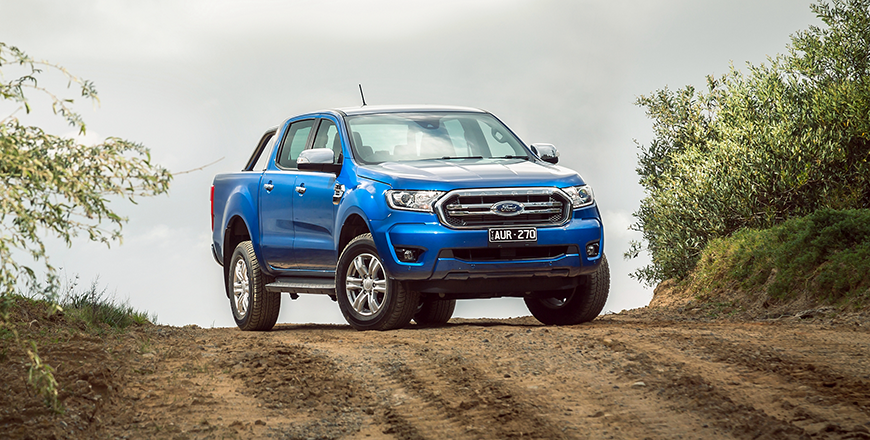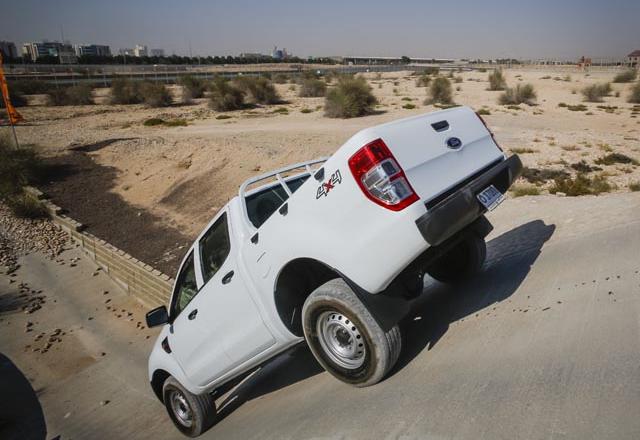You are here
Ford Ranger XLS 2.2 TDCI: Rugged, refined and ever-ready
By Ghaith Madadha - Mar 23,2020 - Last updated at Mar 23,2020

Photo courtesy of Ford
Launched last year globally and arriving in the Middle East for the 2020 model year, the latest face-lifted Ford Ranger incarnation includes a mild aesthetic refresh and the introduction of more advanced technology.
Carrying on with Ford’s venerable 2.2-litre and 3.2-litre turbodiesel and 2.5-litre petrol engines for our region, the revised Ranger line-up includes a raft of improved and updated driver assistance and infotainment across the board.
However, other regions also receive variants of the smaller more powerful 2-litre turbodiesel engine first seem on the more performance oriented Ranger Raptor model.
A much less radical redesign than when the Ranger first received its last major styling overhaul and a new, more aggressive and charismatic, and now signature fascia back in 2015, the latest update carries on with a similar broad and dominant hexagonal grille flanked by dramatic, squinting and heavily browed headlights.
Little changed at initial glance, the Ranger’s visual aggression has however been dialed back slightly. With its grille and lower intake combo now intersected by a more visibly delineated bumper, the Ranger’s cleaner new look exhibits a horizontal, rather than vertical emphasis.
Abundant ability
A capable carryover, the junior of the Ranger’s two turbodiesel engines might not have quite the same effortless muscle and abundant torque as the mighty 3.2-litre 5-cylinder version, but as a 2.2-litre four-cylinder it outperforms most competitors. Using common-rail direct injection and positioned longitudinally to drive the rear wheels in normal conditions, the Ranger’s 2.2-litre TDCI engine produces 158BHP at 3,200rpm and 284lb/ft torque through a wide 1,600-2,500rpm band. This allows the Ranger to carry its 2.1-tonne mass through 0-100km/h in 12.8-seconds and onto 175km/h, while returning 8l/100km combined cycle fuel economy.
Coming one second slower through the 0-100km/h benchmark than its own manual gearbox version, the Ranger 2.2 TDCI is nevertheless a lively drive in its class. Meanwhile turbo lag from very low rpm is less than most similar trucks, and is well masked by its auto gearbox, which does a good job of keeping the Ranger’s revs in its generously rich mid-range. Response from standstill, flexible and confident in mid-range, and comparatively willing at top-end, the Ranger 2.2 TDCI is however in its comfort zone when driven through its maximum torque sweet spot.
Cornering and cruising composure
In terms of refinement, gear shifts are smooth and diesel clatter is less than most and is well subdued in mid-range driving. Driven on mostly smooth roads during test drive, the Range was comfortable, settled and stable at speed, despite its rugged body on frame construction and tough live-axle and leaf spring rear suspension.
Over rutted, pocked and far from perfect highway segments the Range felt composed with little jittering, with its tall sidewall 255/70R16 tyres well absorbing impacts and its ride quality being settled and buttoned down given its commercial vehicle underpinnings.
Riding on more sophisticated double wishbone suspension at the front and with its balanced front-engine and nominal rear-drive set-up, the Ranger turns eager and tidy into corners. Benefitting from Ford’s knack for good steering feel despite its big tyres and long steering ratio, one can easily place the Ranger on road.
Well controlled with comparatively little lean for so tall a vehicle, one however needs to accelerate progressively out of corners to avoid traction control intervening to prevent axle hop, which can happen with almost any truck with similar rear suspension.
Capability and comfort
A rugged workhorse with good turning circle, maneuverability, cargo capacity and up to 3,500kg towing capability, the Ranger is also a thoroughly off-road machine. In addition to generous 232mm ground clearance, 800mm water fording capacity and 28 degree approach, 24 degree break-over and 27 degree departure angles for traversing inhospitable terrain and obstacles, the Ranger’s four-wheel-drive system engages for added off-road ability.
Four-wheel-drive can also be set in low gear ratio mode for enhanced traction and high power crawling for towing or caring loads over particularly bad terrain and inclines, while an optional locking rear differential further improves traction.
Driven in double cab guise with mid-range XLS specification, the Ranger is spacious, comfortable and well – if not over – equipped as a dual work and private use pick-up truck, and features user-friendly layouts, quality fabric upholstery, good visibility and excellent supportive front seats. Generously accommodating five passengers and featuring an assortment of airbags, child seat latches, stability control and other safety features, the new Ranger line includes numerous available driver assistance features. Depending on spec level and market these include lane keeping, hill descent, parking rollover mitigation and many more advanced features.
- Engine: 2.2-litre, common-rail turbo-diesel, in-line 4-cylinders
- Bore x stroke: 86 x 94.6mm
- Compression ratio: 15.7:1
- Valve-train: 16-valve, DOHC
- Gearbox: 6-speed automatic
- Driveline: Four-wheel-drive, low gear transfer case, locking rear differential
- Gear ratios: 1st 4.171:1; 2nd 2.342:1; 3rd 1.521:1; 4th 1.143:1; 5th 0.867:1; 6th 0.691:1
- Reverse / final drive: 3.4:1 / 3.73:1
- High / low range: 1:1 / 2.48:1
- Power, BHP (PS) [kW]: 158 (160) [118] @3,200rpm
- Specific power: 72BHP/litre
- Torque, lb/ft (Nm): 284 (385) @1,600-2,500rpm
- Specific torque: 129Nm/litre
- 0-100km/h: approximately 12.8-seconds
- Top speed: 175km/h
- Fuel consumption, combined; 8-litres/100km
- CO2 emissions, combined: 209g/km
- Fuel capacity: 80-litres
- Length: 5,382mm
- Width: 1,867mm
- Height: 1,815mm
- Wheelbase: 3,220mm
- Ground clearance: 232mm
- Track: 1,560mm
- Overhang, F/R: 928/1,234mm
- Headroom, F/R: 1,022/986mm
- Legroom, F/R: 1,058/902mm
- Shoulder room, F/R: 1,440/1,430mm
- Load floor length: 1,549mm
- Load floor width, min/max: 1,139/1,560mm
- Load floor depth: 511mm
- Loading height: 835mm
- Cargo volume: 1,180-litres
- Water fording: 800mm
- Approach angle: 28°
- Break-over angle: 24°
- Departure angle: 27°
- Kerb weight: 2,119kg (est.)
- Payload: 1,081kg (est.)
- Towing capacity, braked: 3,500kg
- Gross vehicle mass: 3,200kg
- Gross train mass: 6,000kg
- Suspension, F/R: Double wishbones, coilovers / leaf springs, live axle
- Steering: Electric-assisted rack & pinion
- Lock-to-lock: 3.5-turns
- Turning circle: 12.7-metres
- Brakes, F/R: Ventilated discs / drums
- Tyres: 255/70R16
Related Articles
Replacing both American and global market predecessors bearing the same badge, the new Ford Ranger light pick-up is a larger, more refined and more capable successor.
Twice face-lifted since its introduction in 2011, the first generation Ford Ranger, built on the modern “T6” platform, remains as impressive
The range-topping version of Ford’s compact Ranger pick-up model line, the Wildtrak is a thoroughly capable hauler and off-roader with robus


















